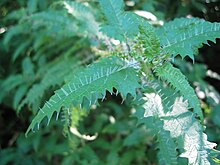Urtica ferox
| Urtica ferox | |
|---|---|
 |
|
| Urtica ferox leaves and spines | |
| Scientific classification | |
| Kingdom: | Plantae |
| (unranked): | Angiosperms |
| (unranked): | Eudicots |
| (unranked): | Rosids |
| Order: | Rosales |
| Family: | Urticaceae |
| Genus: | Urtica |
| Species: | U. ferox |
| Binomial name | |
|
Urtica ferox Georg Forster |
|
Urtica ferox, commonly known as Tree Nettle, or ongaonga in Māori, is a nettle that is endemic to New Zealand. It is sometimes known as "Taraonga", "Taraongaonga" or "Okaoka". Unlike other herbaceous species in the Urtica genus, ongaonga is a large woody shrub. It has woody stems and unusually large stinging spines that can result in a painful sting that lasts several days. The shrub can grow to a height of 3 m (9.8 ft) with the base of the stem reaching 12 cm (4.7 in) in thickness. The pale green leaves are very thin like a membrane, the surface of the leaf, stems and stalks are covered in stiff stinging hairs can grow up to 6 mm (0.24 in) long. These spines are prominent along the salient mid-vein and leaf margin. The leaves range from 3–5 cm (1.2–2.0 in) in width and 8–12 cm (3.1–4.7 in) in length, these are oppositely arranged and there are two stipules per node. The leaf shape is ovulate-triangulate with a serrated leaf margin each bearing a spine of up to 1 m (3 ft 3 in). The spines covering the leaf surface, stem and stalk are generally no larger than 6 mm (0.24 in) in length, the spines on the older darker bark are smaller and softer, these don't cause a sting. This nettle is winter deciduous in cold climates, evergreen in mild climates and can lose its leaves in drought conditions if it is growing in shallow soils.
The toxin present in the spines is triffydin (or tryfydin). This toxin contains histamine, serotonin and acetylcholine, the last of which causes powerful stimulation of the parasympathetic nerve system. Multiple stingings can have a very painful reaction which causes inflammation, a rash, itching, and in high concentrations loss of motor movement, paralysis, drop in blood pressure, convulsions, blurred vision and confusion. The toxin from 5 spines is enough to kill a guinea pig.. There has been one recorded human death from contact—a lightly clad hunter who died five hours after walking through a dense patch. Acute polyneuropathy can occur due to U. ferox stings.
In Māori folklore, Kupe was said to have placed several obstacles to hinder pursuers whose wives he had stolen, one of which was the ongaonga.
...
Wikipedia
